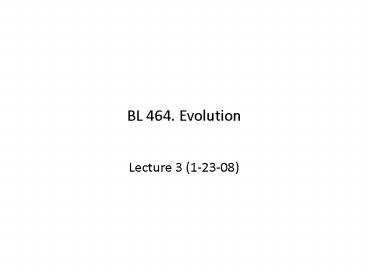BL 464. Evolution - PowerPoint PPT Presentation
BL 464. Evolution
stratigraphy. Absolute dating. radiometric. Absolute dating fossils. Radiometric dating. Based on rates of radioactive decay of an element or isotope into a different ... – PowerPoint PPT presentation
Title: BL 464. Evolution
1
BL 464. Evolution
- Lecture 3 (1-23-08)
2
Transitional forms Whales
3
Transitional forms Birds
4
(No Transcript)
5
Vestigial organs
6
A transitional form
7
Law of succession
Extant
Extinct
8
Molecular Homologies
- Genetic similarities among organisms because of
shared ancestry.
9
Shared Genetic code
10
A shared potential for negative selection
11
Homologous pseudogenes
Genetic markers Immune from delterious mutations
12
Relationship between phylogeny and age
of pseudogenes
13
(No Transcript)
14
- Timeframe for evolution
15
Relative dating stratigraphy
Absolute dating radiometric
16
- Absolute dating fossils
- Radiometric dating
- Based on rates of radioactive decay of an element
or isotope into a different element or isotope. - Rates constant and independent of environmental
factors - The rates of decay are known
- Measuring amount of decay that has taken place
from a parent element (or isotope) into a
daughter element (or isotope) a geologic clock
17
E.g., Potassium/Argon clock
- Decay of 40K produces 40Ar
- Best rocks for K/Ar dating have been formed at
high temperatures - e.g., those derived from volcanic activity
- Heat drives off previously accumulated Argon gas
- Sets the clock to zero
- As rock cools and solidifies, 40K continues to
decay to 40Ar which is trapped inside the rock
18
- To date the rock, it is reheated and the amount
of 40Ar is measured. - The ratio of 40Ar to the amount of 40K present
reveals he time lapse since the rock was formed. - 40K has a half-life of 1.3 billion years.
- In 1.3 billion years, 1/2 of the original 40K
will have been converted to 40Ar - In 2.6 billion years, 1/4 of the original 40K
will remain.
19
Radiometric Dating
1. Determine ratio of parent Isotope to daughter
isotope. 2. Convert ratio to number of
half- lives elapsed. 3. Number of half-lives
that have elapsed X the half-life
estimate of age of the rock.
20
Relative dating of fossils
PowerShow.com is a leading presentation sharing website. It has millions of presentations already uploaded and available with 1,000s more being uploaded by its users every day. Whatever your area of interest, here you’ll be able to find and view presentations you’ll love and possibly download. And, best of all, it is completely free and easy to use.
You might even have a presentation you’d like to share with others. If so, just upload it to PowerShow.com. We’ll convert it to an HTML5 slideshow that includes all the media types you’ve already added: audio, video, music, pictures, animations and transition effects. Then you can share it with your target audience as well as PowerShow.com’s millions of monthly visitors. And, again, it’s all free.
About the Developers
PowerShow.com is brought to you by CrystalGraphics, the award-winning developer and market-leading publisher of rich-media enhancement products for presentations. Our product offerings include millions of PowerPoint templates, diagrams, animated 3D characters and more.































